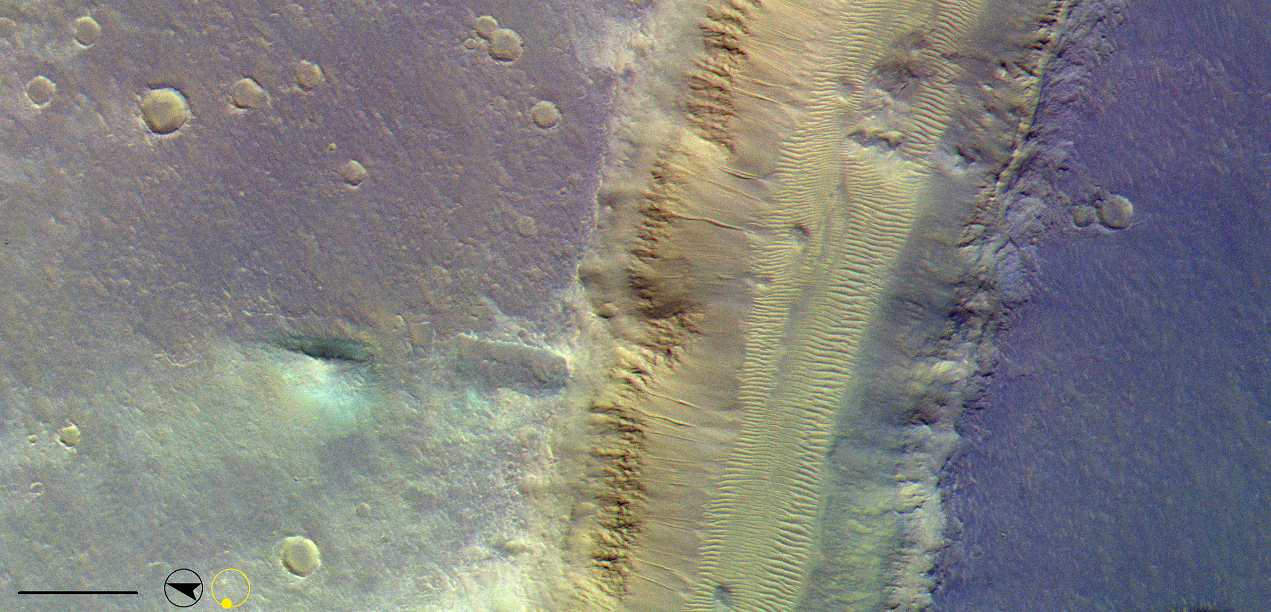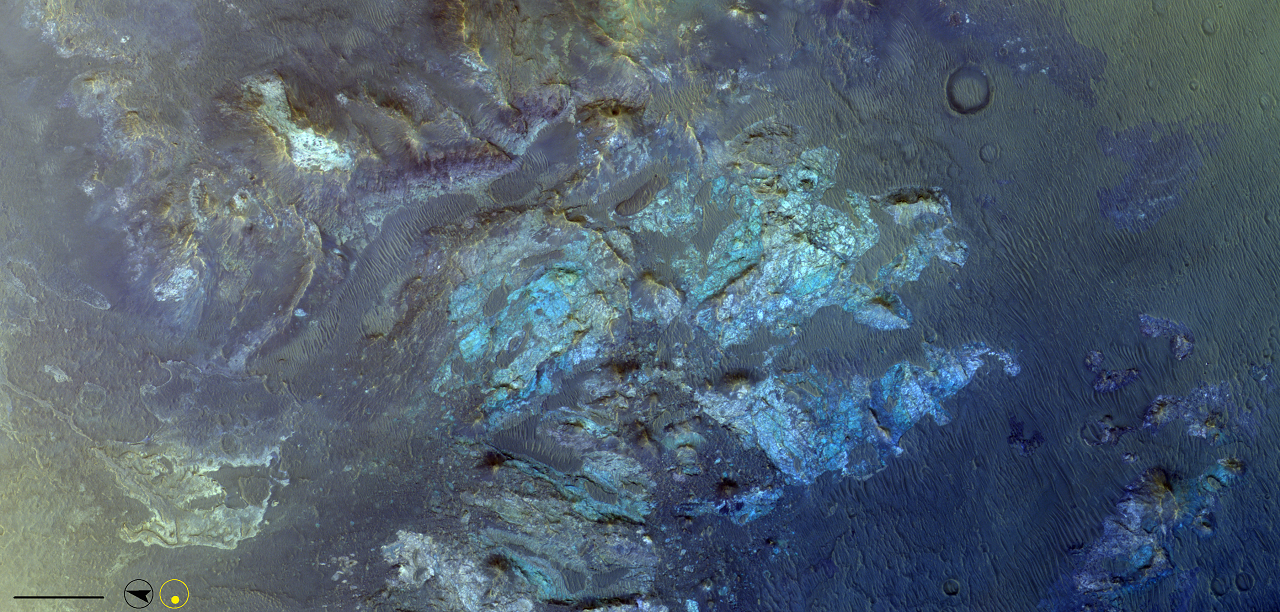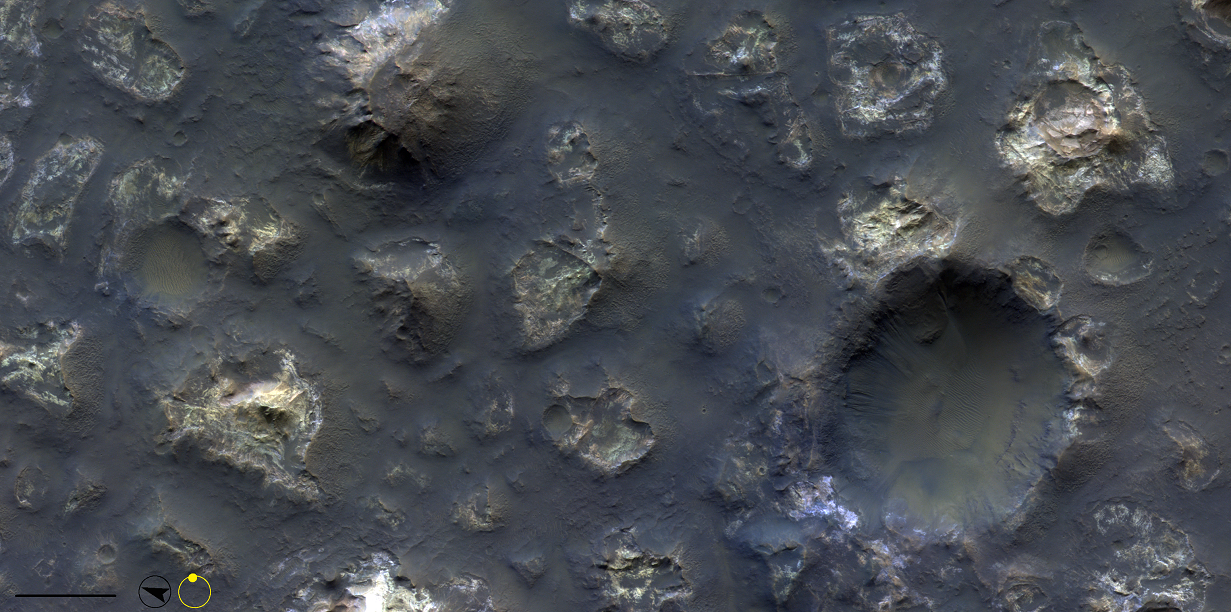Images from the CaSSIS book
Alluvial fan in Jezero crater
Image: MY34_004069_162_1
Acquisition time: 2018-10-22T02:43:16.568
Longitude: 77.3E, Latitude: 18.8N
Region: Syrtis Major
Jezero is a 45km diameter crater that was selected as the landing site for NASA’s Mars 2020 rover, Perserverance. The crater contains this fan-delta deposit (centre bottom) which is rich in clays. It is thought that Jezero was once flooded at a time when valley networks were forming on Mars. Note the sinuous channel to the east (top).
Trough in Noachis
Image: MY35_013386_213_0
Acquisition time: 2020-11-22T21:06:28.980
Longitude:318.6E
Latitude:27.9S
Region: Noachis
This is an image of Nirgal Vallis in Noachis Terra. This valley is around 610 km long and would have discharged its water into Uzboi Vallis and from there into Holden Crater. This image shows gullies on the north side (left side) of the valley and also shows compositional diversity on the plain to the north. The tributaries of Nirgal Vallis are very short and stubby. This has been interpreted as indicating valley formation through a sub-surface source of water rather than precipitation or melting ice on the surface.
Incised crater rim within Morella Crater
Image: MY34_004198_191_0
Acquisition time: 2018-11-01T16:15:21.016
Longitude: 308.9E
Latitude: 9.5S
Region: Marineris
This crater is within the 77 km diameter Morella Crater and just to the north-east of Ganges Cavus in the Valles Marineris region. The east wall of Morella Crater was breached and this may have led to the erosion of the crater walls of this smaller crater within. Morella Crater contains low-silica, Mg-rich lava and ash which probably leads to the colourful terrain surrounding the crater. Note also the valley structures to the south (right) of the crater.
Eroding polar terrain
Image: MY35_013691_268_0
Acquisition time: 2020-12-17T20:46:36.274
Longitude: 198.9E
Latitude: 74.0S
Region: Parva
This image is from a sequence of images obtained from Reynolds Crater in Parva Planum. This particular image was obtained in mid-autumn in the southern hemisphere of Mars. The seasonal ice cap has mostly sublimed by this time in the Martian year revealing the surface below. Here we see eroding terrains and sharp boundaries in surface brightness and colour.
A plethora of different surface types
Image: MY36_014436_039_0
Acquisition time: 2021-02-16T19:33:01.431
Longitude: 354.0E
Latitude: 37.3N
Region: Arabia
The south wall of this crater (right) close to the dichotomy boundary has three large gully structures that have contributed to the build-up of material at the base of the crater wall. There seem to be flow features leading down to the centre of the crater where there is a remarkable structure with fractures.
Fractured bedrock in the central peak of a crater
Image: MY34_004219_201_1
Acquisition time: 2018-11-03T09:33:06.089
Longitude: 62 .6E
Latitude: 18.4S
Region: Tyrrhena Terra
The central peak of a 51 km crater that lies south-east of Huygens crater on the westmost side of Tyrrhena Terra. The greenish coloured material is heavily fractured. There are parallel dune structures surrounding the uplift on most sides. There are also some exposures of lighter-toned material to the north (left).
Colourful eroded mounds in Terra Cimmeria
Image: MY34_002015_220_0
Acquisition time: 2018-05-07T00:45:53.000
Longitude : 164.0E Latitude : 36.9S
Region: Cimmeria
This image is of a small unnamed area in Terra Cimmeria that is known for containing chaotic terrain. However, the structures here are very different from those found in, for example, Aram Chaos. The surface appears to have been heavily eroded, revealing bright, colourful material. The crater to the right shows exposed brighter bedrock in the rim and the west (lower) wall.
Colour diversity in Wirtz Crater
Image: MY35_011185_231_0
Acquisition time: 2020-05-26T15:59:05.803
Longitude: 334.9E
Latitude: 47.5S
Region: Noachis
This image shows the north-east wall and floor of the 120 km diameter Wirtz Crater. The crater is to the east of Argyre Planitia in Noachis Terra. Only the southern rim of Wirtz has been studied with the high resolution imaging spectrometer, CRISM, and that dataset did not show anything particularly interesting. However, this image shows spectacular colour diversity. Note also that the floor of the crater exhibits polygonal patterned ground.








